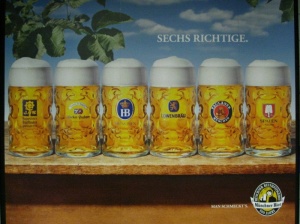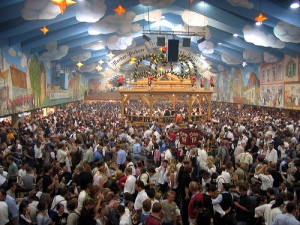Sadly, tomorrow marks the last official day of the world’s largest folk festival – Oktoberfest. And unfortunately, yet another Oktoberfest has come and gone without me. I vow to make the trek to Munich for this event some day! Until then, I will live vicariously through the stories of others while sipping on some Oktoberfest-bier.
Speaking of Oktoberfest bier, although the official festival ends tomorrow – the Oktoberfest spirit still lives on through the beer! (Which should remain on store shelves for another couple of weeks!)
So, what is so special about Oktoberfest bier? Oktoberfest bier rules are similar to the Trappist beer laws in Belgium in that the beer must be brewed in a certain style within a certain location and only a few breweries can actually carry the official name “Oktoberfest.”
Authentic Oktoberfest bier is brewed only by the breweries within the city limits of Munich. There are several breweries outside of Munich, including U.S. craft breweries, that brew beers in the Oktoberfest style. Technically, they are not authentic and must be labeled Oktoberfest-style beer. (Just like how any beer brewed to emulate the Abbey ale style must be labeled Abbey-style).
And as with the Belgian Trappist beers, only a select number of breweries in Munich are officially sanctioned as Oktoberfest brewers. The official breweries of Oktoberfest include: Spaten, Löwenbräu, Augustiner, Hofbräu, Paulaner and Hacker-Pschorr. These “Big Six” are the ONLY breweries allowed to participate in the annual Munich Oktoberfest.
The story of how Oktoberfest bier came to be is a classic story – very similar to the foundation stories of many other styles of beer. Once upon a time, the brewers of Bavaria had difficulty controlling the quality of beer in the hot summer months. A combination of heat and bacteria would cause the beers to sour and spoil.
In order to remedy this problem, Bavarian brewers resorted to two simple but effective solutions.
One solution was to increase the level of natural preservatives in the beers. They achieved this by adding more hops to the brewing process as well as increased the alcohol content of the beers by brewing them at a higher gravity.
A second solution was to change the schedule of the brewing season. After much trial and error, Bavarian brewers learned that brewing between early October and the end of March tended to produce the best tasting beer. And this is how the Märzen-Bier was born.
FYI: Märzen-Bier in German translates to March Beer in English.
In order to maintain freshness during the hot summer months, brewers stored casks of Märzen beer in cool cellars and mountain caves (in the Alps) which were often filled with blocks of ice from the winter.
The preservative qualities of possessing high alcohol and hop contents in combination with the ideal storage conditions of the mountain caves and cool cellars ensured that the beer kept well – even matured and improved as summer turned into fall!
Just like Cinderella had to be home by midnight, all of the old Märzen casks needed to be returned to the brewers by October so that they could begin brewing another years worth. And naturally, the casks needed to be empty – which meant that the last of the Märzen beer needed to be consumed.
And as fate would have it, Munich just happened to host an enormous folk fest in the world at the end of September through the beginning of October. And what better time and place to consume the last of the Märzen beers than Oktoberfest? This is how Märzen-biers became known as Oktoberfestbiers – what they are most commonly referred to as today!
Oktoberfest biers have been served at the festival in Munich since 1818. Advances in technology and the science of brewing led to the evolution of the Märzen-Oktoberfest styles. The Oktoberfest recipe was first revolutionized in 1941 by Gabriel Sedlmayr, former owner of Spatan Brewery of Munich, and Anton Dreher, former owner of the Dreher Brewery of Vienna. Together they created the first Märzen “gebraut nach Wiener Art” (brewed the Vienna way). They achieved this by adding a new, slightly caramelized, but fairly pale malt to the grist – which also lightened the color of the beer. This malt is now called Vienna malt.
Spaten Brewery went ahead and revamped the Oktoberfest recipe for a second time in 1871. Spaten helped Oktoberfest beer return back to its Munich roots by brewing it with Munich malt – a slightly darker version of the previously used Vienna malt. This “re-Bavarianized” version of Märzen-bier is the official Oktoberfest bier drank at Oktoberfest today!
The traditional style guidelines describe an amber-gold lager, robust at 5.2 to 6 percent alcohol by volume (ABV), bottom-fermented and lagered for at least a month, with pronounced malt flavors from Vienna [Munich] malts, usually accented by the German noble hops such as Hallertau and Tettnang.
For more information on the history and brewing techniques of Oktoberfestbier, visit the website of the German Beer Institute!
And if you still have not gotten a chance to celebrate Oktoberfest this year – have no fear! Just go out and grab one of the big six Oktoberfest beers or one of the thousands of Oktoberfest-style beers still available today! But hurry … these beers need to be consumed by the end of autumn to make room on the shelves for the winter ales! (Need help choosing one? Try Spaten … after all, its the grand daddy of Oktoberfest-bier!)
CHEERS!









At the grocery store I bought a case of Hofbrau Oktoberfest. Straight from Munich and brewed according to German purity law.
Went to Oktoberfest last year. Mama’s German, we visited family, then treked down to Munich. So, so, so many people. Had our 3 girls with us, will never do that again. The fair, carnival, whatever they had there, the girls had a blast b/c the rides went faster and higher than American rides.
German beer is awesome!! When you go, make sure you get a reservation to sit in the tent. We sat outside, that was fine, but just thinking if it was raining. Tina
Great article…I love Oktoberfest!
When you go to Munchen, take your German father with you; it’s the best way to show him how much you love him.
You must learn the chant:
“Eins, Zwei, Drei . . . Zuppa!”
When it comes to traditional German festbiers it’s hard to top Spaten; as for Americans, I do have a soft spot in my heart for Flying Bison’s scrumptious Oktoberfest. They are the masters of german malts.
Pingback: FuzzyBrew | Why we celebrate Oktoberfest and drink beer